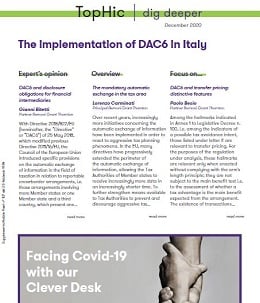-
Transactional advisory services
Find out more about the transactional advisory services of Grant Thornton Financial Advisory Services
-
Valuations
Find out more about the valuations services of Grant Thornton Financial Advisory Services
-
Mergers and acquisitions
Find out more about the merger and acquisition services of Grant Thornton Financial Advisory Services
-
Forensic and investigation services
Find out more about the forensic and investigation services of Grant Thornton Financial Advisory Services
-
Recovery & reorganisation
Find out more about the Recovery & reorganisation services of Grant Thornton Financial Advisory Services
-
Business risk services
Find out more about the business risk services of Grant Thornton Financial Advisory Services
-
Business consulting
Find out more about the business consulting services of Grant Thornton Financial Advisory Services
-
Capital market
Capital market
-
Corporate and business tax
Find out more about our corporate and business tax services.
-
Direct international tax
Find out more about our direct international tax services.
-
Global mobility services
Find out more about our global mobility services.
-
Indirect international tax
Find out more about our indirect international tax services.
-
Transfer pricing
Find out more about our transfer pricing services.
-
Litigation
Our lawyers and accountants can manage all defense measures provided not only by the Italian law, but also by EU regulations and conventions
-
Family business
Find out more about our Family business services.
-
Legal
The client can be assisted in every need and with the same care both on important operations or disputes and on simple matters

-
Back office outsourcing
Find out more about our Back office outsourcing services
-
Business process outsourcing
Find out more about our business process outsourcing services.
-
Compilation of financial statements
Find out more about our compilation of financial statements services.
-
Tax compliance
Find out more about our tax compliance services.
-
Electronic invoicing
Find out more about our electronic invoicing services
-
Electronic storage
Electronic storage is an archiving procedure that guarantees the legal validity of a digitally stored electronic document
-
Revaluation of corporate assets
Find out your civil and fiscal revaluation of tangible, intangible and financial assets
-
Human resources consulting
Find out more about our human resources consulting services.
-
Payroll
Find out more about our payroll services.
-
HR News
HR News the monthly information newsletter by Grant Thornton HR
-
Cybersecurity
GT Digital helps clients structure information security management internal functions, also through partially or totally outsourced functions
-
Agile and Programme Management
GT Digital provides support in the adoption and implementation of different portfolio management
-
Robotic Process Automation
Our “BOT Farm” can rely on digital workers able to help clients in routine activities, allowing employees to deal with more added-value activities
-
Data strategy and management
GT Digital can support clients in seizing the opportunities offered by Big Data, from the definition of strategies to the implementation of systems
-
Enterprise Resource Planning
We support clients in selecting the most appropriate ERP System according to their specific needs, helping them also understand licensing models
-
IT strategy
GT Digital supports clients in making strategic choices, identifying innovation opportunities, comparing themselves with competitors
-
IT service management
We can support with software selection and with the implementation of dedicated tools for the management of ICT processes
-
DORA and NIS 2
The entry into force of the DORA Regulation and NIS2 represents a major step towards the creation of a harmonised regulatory framework
With Directive 2018/822/EU (hereinafter, the “Directive” or “DAC6”) of 25 May 2018, which modified previous Directive 2011/16/EU, the Council of the European Union introduced specific provisions on the automatic exchange of information in the field of taxation in relation to reportable cross-border arrangements (i.e. those arrangements involving more Member states or one Member state and a third country, which present one or more potential tax evasion risk indicators (so-called hallmarks).
It must be specified that the regulation on the matter falls within the scope of the initiatives introduced following the recommendations of action 12 of BEPS, which is focussed on the strengthening of instruments for fighting tax avoidance and tax evasion. In fact, action 12 “[…] provides recommendations for the design of rules to require taxpayers and advisors to disclose aggressive tax planning arrangements. These recommendations seek a balance between the need for early information on aggressive tax planning schemes with a requirement that disclosure is appropriately targeted, enforceable and avoids placing undue compliance burden on taxpayers”.
The abovementioned Directive has been implemented in Italy through Legislative Decree no. 100 dated 30 July 2020 (hereinafter the “Decree”), followed by a proper Decree by the Ministry of Economy and Finance on 17 November 2020 (hereinafter “DM”), including the definition of technical rules and procedures relevant to the mandatory automatic exchange of information on reportable cross-border arrangements.
As for the concerned subjects, the Decree established that the reporting obligation to the Tax Authorities of cross-border arrangements that present one or more hallmarks is on “intermediaries” and, secondarily and only upon meeting certain conditions, on “taxpayers”, i.e. those subjects that could potentially benefit (or benefitted, starting from 25 June 2018, when the Directive came into force) of the effects of cross-border arrangements.
As concerns information on cross-border arrangements that needs to be reported to the Revenue Office, according to art. 6 of the Decree it includes:
- the identification of concerned intermediaries and taxpayers, including their name, date and place of birth or company name, address, residence for tax purpose, tax identification number, and associated companies of such taxpayers;
- hallmarks that characterize the cross-border arrangement (and that, therefore, make it reportable);
- a summary of the content of the reportable cross-border arrangement;
- the starting date of the cross-border arrangement;
- the domestic regulations that establish the reporting obligation of the cross-border arrangement;
- the value of the reportable cross-border arrangement;
- the identification of the tax residence jurisdictions of concerned taxpayers, as well as any other jurisdictions potentially concerned by the reportable cross-border arrangement;
- the identification of any other subject being potentially concerned by the cross-border arrangement and of any jurisdictions which such subject is referred to.
Considered such regulatory framework, a circular letter is awaited, that could explain and better define some of the issues that are still unclear.
For the purposes concerned by this analysis, it is pointed out that financial intermediaries that are subject to the reporting obligation of information relevant pursuant to the regulation on the Common Reporting Standard automatic exchange of information under art. 1, para. 1, letter n) of Ministerial Decree no. 28/12/2015 (such as banks, centralised financial instruments management companies, stock brokerage companies (SIM), asset management companies (SGR), insurance companies, undertakings for collective investments in transferable securities (UCITS), fiduciary companies, trusts, permanent establishments of foreign financial institutions that carry out the same activities as the financial institutions subject to the reporting obligation) be included, in their quality as intermediaries, among the entities being subject to the new reporting obligation of cross-border arrangements and, more specifically, of those presenting hallmarks regarding the automatic exchange of information and the beneficial ownership listed under category D of Annex I of the Decree (i.e. those hallmarks (i) having the effect of undermining the reporting obligation under the laws on the automatic exchange of Financial Account information (CRS or FACTA), and (ii) involving a non-transparent legal or beneficial ownership).
Interesting interpretations of the abovementioned cross-border arrangements are included in the “Model Mandatory Disclosure Rules for CRS Avoidance Arrangements and Opaque Offshore Structures” issued by OECD on 9 March 2018. More specifically, this document includes some first considerations on (i) those schemes aimed at undermining the exchange of information, for example, the use of instruments similar to financial accounts but that, in fact, are not financial accounts, the transfer of financial assets in jurisdictions that are not bound to the exchange of information, the reclassification of income and capital into products or payments that are not subject to the automatic exchange (so-called “CRS avoidance arrangements”), or (ii) those schemes that use people, legal frameworks or legal persons that do not have an actual economic activity and characterized by an opaque structure aimed at hindering the identification of the beneficial owner (so-called “Opaque offshore structures”).
Given the above, it must be pointed out that the primary legislator’s objective was the timely identification of arrangements capable of compromising the correct fulfilment of the reporting obligations for the automatic exchange of information on financial accounts (in other words, the identification of transactions aimed at avoiding the rules provided by the Common Reporting Standard, which regulate the procedures for the collection of information relevant to the availability of a financial asset at a certain date).
Subsequently, unlike what is provided by the Common Reporting Standard, intermediaries will need to acquire proper instruments and procedures to map and assess those transactions being subject to the reporting obligation.
A critical interpretation of the regulation allows observing that domestic forecasts are somehow halfway between a further transparency obligation towards the Tax Authorities and the Tax Authorities’ trend to carry out – on taxpayers and operators that act transnationally – an increasing and more pervasive preventive compliance activity.
However, the retroactive effect of the Directive implies the assessment of such compliance also with regard to the last two years, thus generating an obligation and, presumably, considerable costs for intermediaries, which add to the obligations provided under the Common Reporting Standard.
Therefore, it is crucial for involved subjects to outline, in the following weeks, an action plan aimed at identifying, first of all, the current perimeter of fulfilments provided under the abovementioned Common Reporting Standard and assess their validity for the purposes of the Decree, as concerns both their ability to identify suspicious situations and the need to standardize an objective approach to the issue.
Then, it will be important to identify and analyse what is not relevant (or what has not been considered) for the purposes of the Common Reporting Standard, in order to evaluate their possible relevance for DAC6 purposes. As an example, we could mention the case in which some investment is used, which do not fall within the definition of financial account (or which do not appear as financial accounts, though having similar characteristics), or the transfer of financial accounts or assets to jurisdictions that are not bound to the Common Reporting Standard.
Moreover, the different terms required under the two regulations (i.e. annual fulfilments, as required under the Common Reporting Standard, against fulfilments within 30 days from the occurrence of the conditions giving rise to the reporting obligation, as required under DAC 6) will inevitably lead operators to acquire mapping and analysis instruments that could work simultaneously and that can identify junctions of the regulations, as well as their specific differences.
It will therefore be crucial, in the following weeks, to identify an operating action plan that, starting from rules available to financial intermediaries for the purposes of the Common Reporting Standard, could test transactions implemented or concluded starting from 25 June 2018, evaluate the possible application for DAC6 purposes (also based on the “reasonably be expected to know” concept) and, once a sufficient number of similar transactions is identified, reach a clustering that allows a correct and timely management of the new reporting obligations, considering the need to blend the operating efficiency (an update of the IT systems will subsequently be necessary) and a qualitative evaluation of each specific case, which cannot be referred – also due to clear responsibility issues – to a mere automated procedure.


